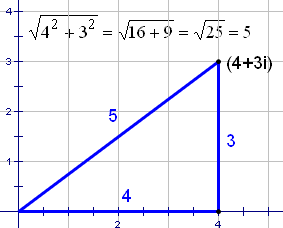Magnitude
Pronunciation: /ˈmæg.nɪˌtud/ ExplainThe magnitude of a point in a coordinate system is the distance of that point from zero.[2] For real numbers, the magnitude is also called the absolute value. Magnitude (and absolute value) are written using a vertical line '|'.
The magnitude of x is written |x|. The magnitude of -7 is written |-7|.
 Figure 1: Number line showing that 3 and -3 are both a distance of 3 from zero. |
The number line in figure 1 shows that both the numbers 3 and -3 are a distance of 3 from zero.
Vectors
The magnitude of a vector  is
is
 . Example: The magnitude of
< -3, 4 > is calculated using the
distance formula:
. Example: The magnitude of
< -3, 4 > is calculated using the
distance formula:  .
.
Complex Numbers
The definition of magnitude is given as the
distance of a number from zero. For
complex numbers,
the definition holds. Use the distance formula
 ,
where a is the length of one leg from zero and
b is the length of the other leg from zero.
,
where a is the length of one leg from zero and
b is the length of the other leg from zero.
Take the complex number 4+3i. Figure 2 shows what this point
looks like when plotted on the complex plain.
 Figure 2: The complex number 4 + 3i plotted on the complex plane |
We can also use the distance formula to calculate the magnitude of 4+3i:

Note that magnitude is always positive or zero. It can never be negative.
References
- McAdams, David E.. All Math Words Dictionary, magnitude. 2nd Classroom edition 20150108-4799968. pg 112. Life is a Story Problem LLC. January 8, 2015. Buy the book
- Fine, Henry B., Ph. D.. Number-System of Algebra Treated Theoretically and Historically. 2nd edition. www.archive.org. pp 28-51. Last Accessed 9/2/2018. http://www.archive.org/stream/thenumbersystemo17920gut/17920-pdf#page/n37/mode/1up/search/modulus. Buy the book
Cite this article as:
McAdams, David E. Magnitude. 4/24/2019. All Math Words Encyclopedia. Life is a Story Problem LLC. http://www.allmathwords.org/en/m/magnitude.html.Image Credits
- All images and manipulatives are by David McAdams unless otherwise stated. All images by David McAdams are Copyright © Life is a Story Problem LLC and are licensed under a Creative Commons Attribution-ShareAlike 4.0 International License.
Revision History
4/24/2019: Changed equations and expressions to new format. (McAdams, David E.)3/23/2019: Clarified magnitude of a vector. (McAdams, David E.)
12/21/2018: Reviewed and corrected IPA pronunication. (McAdams, David E.)
9/2/2018: Removed broken links, updated license, implemented new markup. (McAdams, David E.)
8/7/2018: Changed vocabulary links to WORDLINK format. (McAdams, David E.)
12/19/2009: Added "References". (McAdams, David E.)
12/18/2009: Added more information. (McAdams, David E.)
3/11/2008: Added magnitude of a vector. (McAdams, David E.)
7/12/2007: Initial version. (McAdams, David E.)
- Navigation
- Home
- Contents
-
# A B C D E F G H I J K L M N O P Q R S T U V W X Y Z - Teacher Aids
- Classroom Demos
- How To
- LIASP
- LIASP Home
- Conditions of Use
- Privacy Policy
- Donate to LIASP
- Help build this site
- About LIASP
- Contact LIASP
All Math Words Encyclopedia is a service of
Life is a Story Problem LLC.
Copyright © 2018 Life is a Story Problem LLC. All rights reserved.
This work is licensed under a Creative Commons Attribution-ShareAlike 4.0 International License